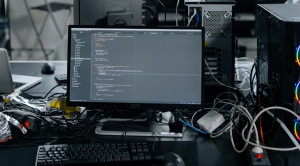What is URL phishing?
You may get questions like "Is a URL like amazonshop.com the same as amazon.com?" or "Is eBay1 the same as eBay?" This is an important warning when receiving email from a website or service you are using. A URL that appears similar to a popular website could actually be a phishing site, created to scam you and steal your personal information. To avoid being scammed, always double check the URL before accessing any website from links in emails.
How does URL phishing work?
URL phishing is a common technique that attackers use to commit fraud and obtain sensitive information from individuals. This method often involves creating fake websites, simulating the look and feel of legitimate websites such as banks, social media platforms or email services. These fake websites are often equipped with URLs that are easily confused with the websites they are imitating.
How to perform URL phishing usually includes the following steps:
Step 1: Cyber criminals create fake websites, copying the look and feel of legitimate websites and providing them with URLs that users can easily mistake for real websites.
Step 2: Then, scammers will use means such as email, text messages or social network messages to lure users to visit these fake websites.
Step 3: When users access, they will be asked to provide personal information such as username, password, credit card information or social security number through forms on the fake website.
Step 4: The information provided by the victim will be used for many different fraudulent purposes, including unauthorized access to accounts, financial theft, identity theft, and even selling information on the dark web .
How to identify a URL phishing attack
Before conducting any online activity, we recommend that you carefully read the URL displayed in your browser's address bar. Phishing sites will often try to emulate the URLs of legitimate sites, but there may be minor typos, extra characters, or even domain changes such as .net instead of .com.
Also, always look out for the "HTTPS" icon in your browser's address bar. The presence of this icon indicates that the website is encrypted, increasing the security of information. On the contrary, if there is no "HTTPS" symbol but instead "HTTP", it is a sign that the website is not secure and is much more suspicious. Reputable organizations will often not use the HTTP protocol and will instead prioritize HTTPS to protect user data.
3. Be careful of unsolicited requests
Be careful of any emails, texts or social media messages asking you to click on links, especially when the website asks for sensitive information. Typically, legitimate organizations will not request personal information through unsolicited messages.
Please check the sender's email address if you receive an email. While it may appear valid at first glance, it can sometimes contain minor differences such as replaced characters or extra words. Furthermore, scammers often use urgent language to create a sense of panic or urgency, to motivate you to make a decision.
If you have any doubts about the authenticity of an email or message, report it as spam and block the sender immediately.
How to protect against URL phishing?
1. Filter URLs
URL filtering is a common method used to control access to websites or content based on their URL addresses. This is a way to manage web content that users can access, often applied in organizational networks, and is also part of parental control systems. URL filtering has the ability to prevent users from visiting fraudulent or suspicious websites by checking visited URLs against a database of previously known or malicious websites.
Many web browsers offer extensions or add-ons to filter and block access to specific URLs. Furthermore, you can also download antivirus programs with URL filtering capabilities or manually configure it yourself by visiting your router's admin page. This helps enhance network security and protect personal information when using the internet.
2. Check domain reputation
A domain's reputation typically reflects its trustworthiness or safety rating, which is assessed based on a range of different factors such as past behavior, the age of the domain, and its history of activity. related to causing harm. There are tools and browser extensions available to automatically check and report on the reputation of websites, helping users evaluate the safety of the domains they visit. This provides an effective means of protecting yourself from malicious or fraudulent websites on the internet.
3. AI-based protection
The increased use of artificial intelligence (AI) and machine learning in cybersecurity is becoming more widespread, helping to identify and respond to threats effectively. AI algorithms are capable of analyzing patterns, detecting unusual activities and predicting potential phishing threats, even if they bear no resemblance to any previously known attacks. These protections can be built into your email service to alert you to potential phishing attempts, providing an additional layer of protection in defending against online threats. .
4. Verify DMARC
DMARC (Domain-based Message Authentication, Reporting, and Conformance) is an email security protocol that plays an important role in authentication, reporting, and compliance. This protocol uses two different methods, SPF (Sender Policy Framework) and DKIM (DomainKeys Identified Mail), to verify that the email was actually sent from the domain it claims to be. SPF checks whether the email was sent from a valid server for that domain, while DKIM ensures the email content is not altered during transmission.
After performing these checks, DMARC ensures that the domain in the email's "From" address matches the verifications performed. Based on the policies the domain owner has set up, DMARC will tell the email server what action to take on emails that don't pass these checks — whether it's to ignore, quarantine or reject them. At the same time, DMARC also reports on which emails were delivered or failed to domain owners, helping them track and monitor domain usage accurately and securely.
5. Security awareness
Education and increased awareness of common phishing tactics such as phishing, email or phishing scams can help prepare individuals to recognize and avoid these threats. Understanding URL phishing techniques, such as recognizing subtle signals in links, can help detect phishing attempts early, such as misleading URLs or emergency language in email.
Training programs, especially in companies, play an important role because keeping employees informed about threats can directly impact their credentials and can lead to leading to negative consequences for many customers. Training helps improve employee vigilance and awareness skills, thereby enhancing safety and protecting everyone's personal information.
How do you know if a URL is safe?
1. Check HTTP
Checking that the URL begins with "https://" is an important step in ensuring the security of your website. The presence of "https://" indicates that the website is using encryption to protect data transmission between your browser and the website's server. This is especially important when you are transacting personal or financial information, because encryption helps prevent hackers or other attackers from stealing your information during data transmission.
2. Find spelling errors
It's important to note typos, character substitutions (like '0' instead of 'o'), or unusual domain extensions in the URL. Scammers often create fake URLs that simulate legitimate URLs to deceive users. Identifying and avoiding these suspicious URLs can help you avoid potential risks related to fraud and loss of personal or financial information.
3. Hover over links before clicking
If you receive an email that contains a suspicious link, hover over the link without clicking. This action helps you check if the URL matches what is displayed. This way, you can quickly evaluate the legitimacy of the link without having to click, helping to minimize the risk of being scammed or losing personal information.
4. Verify short links before clicking
Don't forget about shortened links from sites like bit.ly or tinyurl, too. While not all of these links are unsafe, they can hide the true destination of the page you intend to visit, which could be used by scammers to commit fraud. Before clicking on any shortened link, use the URL expansion service to display the full URL before taking any action, helping you identify risks and ensure your safety. to websites on the internet.
5. Verify by assessment or report
There are various online services you can use to analyze the safety of a URL. These services include Google's Safe Browsing Transparency Report, Norton Safe Web, and VirusTotal. Additionally, you can also use online tools to check the age of the domain name. New domains are often used maliciously, while older and more established domains are often seen as more trustworthy. Using these services and tools can help you evaluate and make safe decisions when accessing websites on the internet.
6. Use browser safety features
Modern browsers incorporate safety features such as warnings about suspicious or risky websites. Ensuring that these features are enabled will keep you safe and away from unsafe links.










